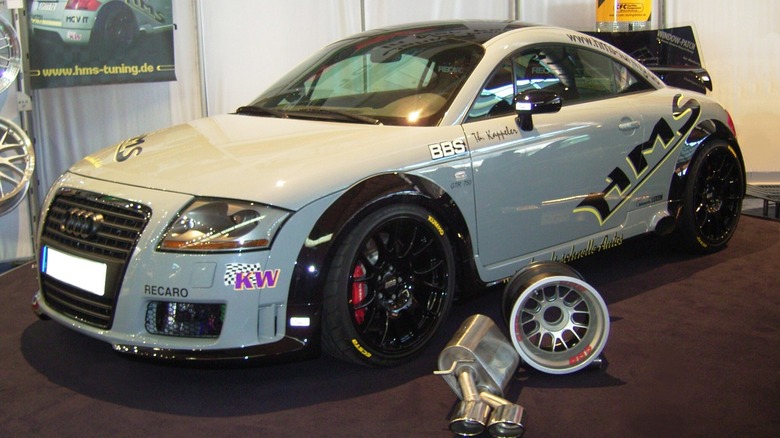Here's What Made The Audi/VW 1.8L Turbo Such A Great Engine
At the dawn of the 1990s, German automaker Audi was struggling. Although it was found faultless in the "unintended acceleration scandal," the negative publicity dinged sales numbers considerably, which wasn't helped by an aging range of products. In short, Audi needed a win badly and surprisingly, it would up scoring several.
First up was the Audi A4 compact sedan, then larger A6 executive sedan, and finally the playful TT sport car. What all of these have in common is the base powerplant: the Volkswagen Audi Group (VAG) 1.8 liter, 20 valve, four-cylinder turbocharged wonder. Initially developed by Audi, reminiscent of the 20 valve engine in the famous ur-Quattro rally racer, the 1.8L turbo found its way into no less than 16 VAG products; including Volkswagen's Beetle and Passat in the United States.
What's so special about the 1.8L turbo? Its 20 valves are distributed across just four cylinders, not five cylinders like prior Audis. That translates to five valves per cylinder — three intake valves and two exhaust — which permits better airflow through the cylinder head, and more power.
Audi's first experiment with five valves per cylinder was in 1988 with a 2.2 liter inline five-cylinder engine that made 650 horsepower, and went on to break long-distance speed records set by Mercedes a decade earlier. Other automakers like Ferrari and Toyota also dabbled in the technology, but the VAG 1.8 liter turbo was the most commercially successful example.
[Featured image by Stefan-Xp via Wikimedia Commons | Cropped and scaled | CC BY-SA 3.0]
A popular platform for hot rodding
Besides 5 valves per cylinder, the 1.8 liter turbo boasted a durable iron engine block with aluminum cylinder head. Inside the block, there are 100% forged internals, including crankshaft, connecting rods, and pistons. The incoming air to the turbocharger was fed through a single air-to-air intercooler.
The initial version of the engine for the 1995 model year made 150 horsepower and 155 pound-feet of torque. In a 1997 test by MotorTrend, it propelled Audi's A4 sedan from 0-60 mph in 8.0 seconds with a manual transmission, or 9.1 seconds for the automatic.
Over the years, the 1.8T continually evolved, peaking at a whopping 240 horsepower in Audi's 2005-2006 TT quattro sport. The extra power was primarily due to a larger turbocharger that produced 15 psi boost, as opposed to the standard 10 psi. A second intercooler was also fitted to further cool the intake charge. In this guise, the 1.8T enabled the TT to hit 60 mph from a standing start in just 5.9 seconds.
Nowadays, the 1.8T is known as the "small block Chevy of Europe" to old-world hot rodders, due to its affordable price and widespread availability in VAG brands like SEAT and Skoda, which we don't get in America.
